Revealing the Effect of α’ Decomposition on Microstructure Evolution and Mechanical Properties in Ti80 Alloy
Abstract
:1. Introduction
2. Experimental Procedures
3. Results
3.1. Mechanical Properties and Fracture Morphology
3.2. Microstructures Characteristics
4. Discussion
4.1. Effect of α’ Decomposition on Microstructure Evolution
4.2. Effect of Microstructure Evolution on Mechanical Properties
5. Conclusions
- (1)
- The YTS, UTS, and elongation of the ST sample reached 898 MPa, 1083 MPa, and 7.7%, respectively. Then, after subsequent aging for 5 h, the strength and plasticity of the STA-1 specimen were synergistically improved, with the YTS, UTS, and elongation reaching 1012 MPa, 1126 Mpa, and 8.1%, respectively. With further extension of the aging time to 24 h, the YTS and UTS of the STA-2 sample were reduced to 871 MPa and 958 Mpa, respectively, and the elongation increased to 10.2%.
- (2)
- The microstructures of the three specimens were mainly composed of equiaxed αp and αs (α’). For ST sample, the microstructure consisted of equiaxed αp + acicular α’. After subsequent aging, α’ decomposed into αs and nano-β phases in STA-1 and STA-2 specimens. Furthermore, as the aging time was extended, the dislocation density decreased, while the size of the αs and nano-β phases gradually increased.
- (3)
- The mechanical properties of the heat-treated samples were affected by the initial dislocation density, the size effect of αs, and nano-β. The fine lamellar αs and nano-β phase can effectively impede the movement of dislocations during plastic deformation, thus achieving alloy strengthening. Based on the above principles, a microstructures–properties correlation model of Ti80 alloy was constructed.
- (4)
- The distribution of slip traces in the supplementary 3% tensile experiments of heat-treated specimens was different. This suggests that α’ decomposition results in an increase in βt hardness, which was the primary cause of the significant strength increase observed in the STA-1 specimen.
Author Contributions
Funding
Institutional Review Board Statement
Informed Consent Statement
Data Availability Statement
Conflicts of Interest
References
- Wang, Q.; Ren, J.Q.; Wu, Y.K.; Jiang, P.; Li, J.Q.; Sun, Z.J.; Liu, X.T. Comparative study of crack growth behaviors of fully-lamellar and bi-lamellar Ti-6Al-3Nb-2Zr-1Mo alloy. J. Alloys Compd. 2019, 789, 249–255. [Google Scholar] [CrossRef]
- Gao, F.; Gao, Q.; Jiang, P.; Liu, Z.; Liao, Z. Microstructure and mechanical properties of Ti6321 alloy welded joint by EBW. Int. J. Lightweight Mater. Manuf. 2018, 1, 265–269. [Google Scholar] [CrossRef]
- Gaillard, Q.; Boulnat, X.; Cazottes, S.; Dancette, S.; Desrayaud, C. Strength/ductility trade-off of Laser Powder Bed Fusion Ti-6Al-4V: Synergetic effect of alpha-case formation and microstructure evolution upon heat treatments. Addit. Manuf. 2023, 76, 103772. [Google Scholar] [CrossRef]
- Youn, S.; Kim, Y.; Kim, H. Improvement in the high temperature mechanical properties of additively manufactured Ti–48Al–2Cr–2Nb alloy using heat treatment. Intermetallics 2023, 153, 107784. [Google Scholar] [CrossRef]
- Wang, K.; Wu, M.; Yan, Z.; Li, D.R.; Xin, R.L.; Liu, Q. Microstructure evolution and static recrystallization during hot rolling and annealing of an equiaxed-structure TC21 titanium alloy. J. Alloys Compd. 2018, 752, 14–22. [Google Scholar] [CrossRef]
- Shahmir, H.; Langdon, T.G. Using heat treatments, high-pressure torsion and post-deformation annealing to optimize the properties of Ti-6Al-4V alloys. Acta Mater. 2017, 141, 419–426. [Google Scholar] [CrossRef]
- Zhu, W.; Lei, J.; Su, B.; Sun, Q. The interdependence of microstructure, strength and fracture toughness in a novel β titanium alloy Ti-5Al-4Zr-8Mo-7V. Mater. Sci. Eng. A 2020, 782, 139248. [Google Scholar] [CrossRef]
- Hirano, T.; Murakami, T.; Narushima, T.; Ouchi, C. Variations in the Microstructure and Hardness with Solution Treating and Aging Conditions in New α+β Titanium Alloy Ti-4.5Al-6Nb-2Fe-2Mo. ISIJ Int. 2007, 47, 1042–1049. [Google Scholar] [CrossRef]
- Dumas, O.; Malet, L.; Kwaśniak, P.; Prima, F.; Godet, S. Design rules to develop solute lean α+β titanium alloys exhibiting high work-hardening by reorientation induced plasticity. Mater. Sci. Eng. A 2024, 890, 145935. [Google Scholar] [CrossRef]
- Wang, F.; Lei, L.M.; Fu, X.; Song, Z.M.; Shi, L.; Zhang, B.; Zhang, G.P. Effect of heat treatment on microstructures and tensile properties of TA19 alloy fabricated by laser metal deposition. Mater. Sci. Eng. A 2020, 782, 139284. [Google Scholar] [CrossRef]
- Jiang, X.J.; Chen, G.Y.; Men, X.L. Grain refinement and excellent mechanical properties of a Ti-based alloy via laser melting and subsequent low temperature annealing. Mater. Sci. Eng. A 2018, 737, 182–187. [Google Scholar] [CrossRef]
- Ma, X.; Chen, Z.; Xiang, Z.; Zhang, S.; Liu, Y.; Ding, X. Influence of quenching plus aging on microstructures and mechanical properties evolutions for Ti-Al-Sn-Zr-Mo-Si-Nb-Ta-Er-C near-α high temperature titanium alloys. Mater. Today Commun. 2024, 38, 108457. [Google Scholar] [CrossRef]
- Su, J.; Xie, H.; Tan, C.; Xu, Z.; Liu, J.; Jiang, F.; Tang, J.; Fu, D.; Zhang, H.; Teng, J. Microstructural characteristics and tribological behavior of an additively manufactured Ti-6Al-4V alloy under direct aging and solution-aging treatments. Tribol. Int. 2022, 175, 107763. [Google Scholar] [CrossRef]
- Su, J.; Ji, X.; Liu, J.; Teng, J.; Jiang, F.; Fu, D.; Zhang, H. Revealing the decomposition mechanisms of dislocations and metastable α’ phase and their effects on mechanical properties in a Ti-6Al-4V alloy. J. Mater. Sci. Technol. 2022, 107, 136–148. [Google Scholar] [CrossRef]
- Ma, W.; Liu, S.; Zhang, X.; Cheng, B. Microstructural evolution and mechanical properties of hot-rolled Ti-30Zr-5Al-2.5Sn alloy with mixed α and α′ phases. Mater. Sci. Eng. A 2020, 792, 139812. [Google Scholar] [CrossRef]
- Lee, W.; Yeom, J.; Kim, J.; Oh, J.; Lee, T.; Liu, Y.; Li, S.; Nam, T. Precipitation of metastable intermetallic phases and nanoindentation behaviors of a Ti-20Zr-9 Nb-4Sn (at%) alloy during aging treatment. J. Alloys Compd. 2023, 933, 167762. [Google Scholar] [CrossRef]
- Chen, Z.; Xu, L.; Liang, Z.; Cao, S.; Yang, J.; Xiao, S.; Tian, J.; Chen, Y. Effect of solution treatment and aging on microstructure, tensile properties and creep behavior of a hot-rolled β high strength titanium alloy with a composition of Ti-3.5Al-5Mo-6V-3Cr-2Sn-0.5Fe-0.1B-0.1C. Mater. Sci. Eng. A 2021, 823, 141728. [Google Scholar] [CrossRef]
- Sun, S.; Fang, H.; Li, Y.; Chen, R.; Zhu, B.; Guo, J. Formation mechanism of titanium solid solution and its influence on equiaxed behavior of α phase of Ti-5Al-5Mo-5Cr-2Zr-xNb alloys. J. Mater. Res. Technol. 2023, 26, 434–444. [Google Scholar] [CrossRef]
- Matsumoto, H.; Yoneda, H.; Sato, K.; Kurosu, S.; Maire, E.; Fabreg, D.; Konno, T.; Chiba, A. Room-temperature ductility of Ti-6Al-4V alloy with α′ martensite microstructure. Mater. Sci. Eng. A 2011, 528, 1512–1520. [Google Scholar] [CrossRef]
- Zhu, Q.; Yang, X.; Lan, H.; Wang, D.; Lou, H.; Li, J. Effect of solution treatments on microstructure and mechanical properties of Ti-6Al-4V alloy hot rolled sheet. J. Mater. Res. Technol. 2023, 23, 5760–5771. [Google Scholar] [CrossRef]
- Chen, J.; Wang, L.; Fan, Q. Effect of aging temperature on microstructure and mechanical properties of a novel Ti-6121 alloy. J. Alloys Compd. 2023, 947, 169612. [Google Scholar] [CrossRef]
- Mandal, P.K.; Daniel, B.; Mathews, M.S.; Joseph, A.; Siby, C.; Devasia, J. Martensitic transformation in a α+β–Ti alloy after cryogenic treatment and its influencing to low elastic modulus biomaterials. Mater. Today Proc. 2021, 46, 2820–2826. [Google Scholar] [CrossRef]
- Shi, X.; Zeng, W.; Long, Y.; Zhu, Y. Microstructure evolution and mechanical properties of near-α Ti-8Al-1Mo-1V alloy at different solution temperatures and cooling rates. J. Alloys Compd. 2017, 727, 555–564. [Google Scholar] [CrossRef]
- Ahmed, T.; Rack, H.J. Phase transformations during cooling in α+β titanium alloys. Mater. Sci. Eng. A 1998, 243, 206–211. [Google Scholar] [CrossRef]
- Cao, S.; Zhang, B.; Yang, Y.; Jia, Q.; Li, L.; Xin, S.; Wu, X.; Hu, Q.; LIM, C. On the role of cooling rate and temperature in forming twinned α′ martensite in Ti-6Al-4V. J. J. Alloys Compd. 2020, 813, 152247. [Google Scholar] [CrossRef]
- Tunes, M.A.; Gammer, C.; Pfeifer, T.; Musi, M.; Martin, F.; Clemens, H. On the existence of orthorhombic martensite in a near-α titanium base alloy used for additive manufacturing. J. Alloys Compd. 2022, 897, 163155. [Google Scholar]
- Abdel-Hady, M.; Fuwa, H.; Hinoshita, K.; Kimura, H.; Shinzato, Y.; Morinaga, M. Phase stability change with Zr content in β-type Ti-Nb alloys. Scr. Mater. 2007, 57, 1000–1003. [Google Scholar] [CrossRef]
- Yi, X.; Sheng, L.; Fu, G.; Sun, B.; Huang, B.; Sun, K.; Meng, X.; Gao, Z.; Zhang, S.; Wang, H. Microstructural design for achieving high performances in Ti-V-Al lightweight shape memory alloys by optimizing Zr content. Mater. Charact. 2023, 205, 113283. [Google Scholar] [CrossRef]
- Nu, H.T.M.; Le, T.T.; Minh, L.P.; Loc, N.H. A Study on Rotary Friction Welding of Titanium Alloy (Ti-6Al-4V). Adv. Mater. Sci. Eng. 2019, 2019, 4728213. [Google Scholar]
- Liang, Z.; Sun, Z.; Zhang, W.; Wu, S.; Chang, H. The effect of heat treatment on microstructure evolution and tensile properties of selective laser melted Ti-6Al-4V alloy. J. Alloys Compd. 2019, 782, 1041–1048. [Google Scholar] [CrossRef]
- Xu, W.; Brandt, M.; Sun, S.; Elambasseril, J. Additive manufacturing of strong and ductile Ti-6Al-4V by selective laser melting via in situ martensite decomposition. Acta Mater. 2015, 85, 74–84. [Google Scholar] [CrossRef]
- Rout, M.; Ranjan, R.; Pal, S.K.; Singh, S. EBSD study of microstructure evolution during axisymmetric hot compression of 304LN stainless steel. Mater. Sci. Eng. A 2018, 711, 378–388. [Google Scholar] [CrossRef]
- Omale, J.; Ohaeri, E.G.; Tiamiyu, A.A.; Eskandari, M.; Mostafijur, K.M.; Szpunar, J.A. Microstructure, texture evolution and mechanical properties of X70 pipeline steel after different thermomechanical treatments. Mater. Sci. Eng. A-Struct. Mater. Prop. Microstruct. Process. 2017, 703, 477–485. [Google Scholar] [CrossRef]
- Luo, Q.; Guo, Y.; Liu, B.; Feng, Y.; Zhang, J.; Li, Q.; Chou, K. Thermodynamics and kinetics of phase transformation in rare earth-magnesium alloys: A critical review. J. Mater. Sci. Technol. 2020, 44, 171–190. [Google Scholar] [CrossRef]
- Huang, S.; Zhang, J.; Ma, Y.; Zhang, S.; Youssef, S.; Qi, M.; Wang, H.; Qiu, J.; Xu, D.; Lei, J.; et al. Influence of thermal treatment on element partitioning in α+β titanium alloy. J. Alloys Compd. 2019, 791, 575–585. [Google Scholar] [CrossRef]
- Wang, S.; Liang, Y.; Sun, H.; Feng, X.; Huang, C. Thermomechanical treatment-induced microstructure refinement to optimize mechanical properties of TC21 titanium alloys. Mater. Sci. Eng. A 2021, 812, 141095. [Google Scholar] [CrossRef]
- Wang, B.B.; Xie, G.M.; Wu, L.H.; Xue, P. Grain size effect on tensile deformation behaviors of pure aluminum. Mater. Sci. Eng. A 2021, 820, 141504. [Google Scholar] [CrossRef]
- Kaushik, H.C.; Korayem, M.H.; Shaha, S.K.; Kacher, J.; Hadadzadeh, A. Achieving strength-ductility synergy in a laser-powder bed fused near-α titanium alloy through well-crafted heat treatments. J. Alloys Compd. 2023, 968, 171913. [Google Scholar] [CrossRef]
- Li, S.; Zhang, L.; Zhang, Y.; Yang, Q. Coherent ω phase induced yield strength improvement in Ti-19Nb-1.5Mo-4Zr-8Sn alloy. Results Phys. 2020, 19, 103366. [Google Scholar] [CrossRef]
- Tan, C.; Sun, Q.; Xiao, L.; Zhao, Y. Slip transmission behavior across α/β interface and strength prediction with a modified rule of mixtures in TC21 titanium alloy. J. Alloys Compd. 2017, 724, 112–120. [Google Scholar] [CrossRef]
- Angelier, C.; Bein, S.; Béchet, J. Building a continuous cooling transformation diagram of β-CEZ alloy by metallography and electrical resistivity measurements. Metall. Mater. Trans. A 1997, 28, 2467–2475. [Google Scholar] [CrossRef]
- Mantri, S.A.; Choudhuri, D.; Alam, T.; Viswanathan, G.B. Tuning the scale of α precipitates in β-titanium alloys for achieving high strength. Scr. Mater. 2018, 154, 139–144. [Google Scholar] [CrossRef]
- Yue, K.; Liu, J.; Zhu, S.; Wang, L.; Wang, Q.; Yang, R. Origins of different tensile behaviors induced by cooling rate in a near alpha titanium alloy Ti65. Materialia 2018, 1, 128–138. [Google Scholar] [CrossRef]
- Harr, M.E.; Daly, S.; Pilchak, A.L. The effect of temperature on slip in microtextured Ti-6Al-2Sn-4Zr-2Mo under dwell fatigue. Int. J. Fatigue 2021, 147, 106–173. [Google Scholar] [CrossRef]
- Wang, K.; Yan, Z.; Zhou, Y.; Wei, S.; Wang, X.; Xin, R.; Liu, Q. Slip initiation in interlayered β and corresponding slip transfer during compression of a lamellar-structure titanium alloy. Results Phys. 2020, 18, 103276. [Google Scholar] [CrossRef]

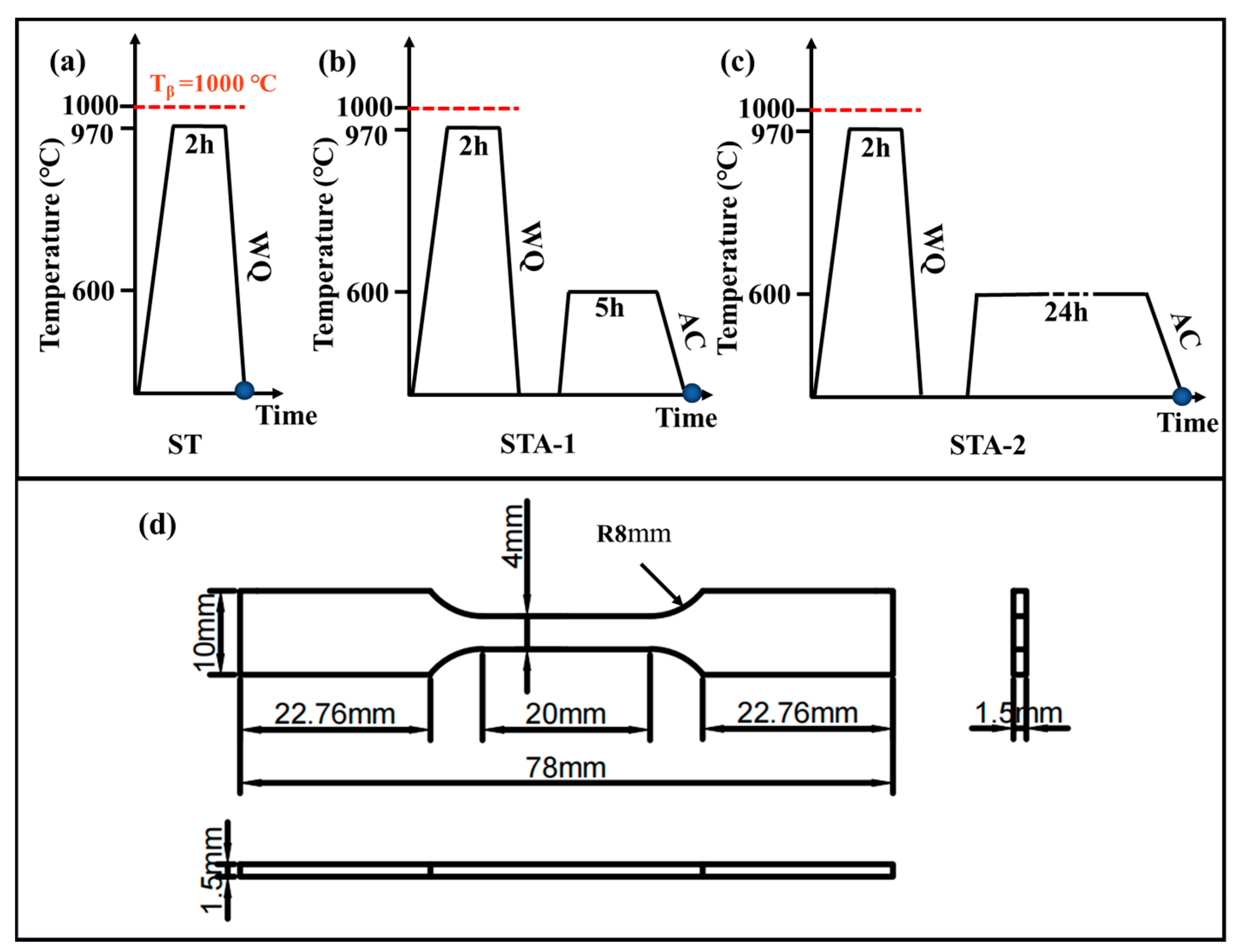
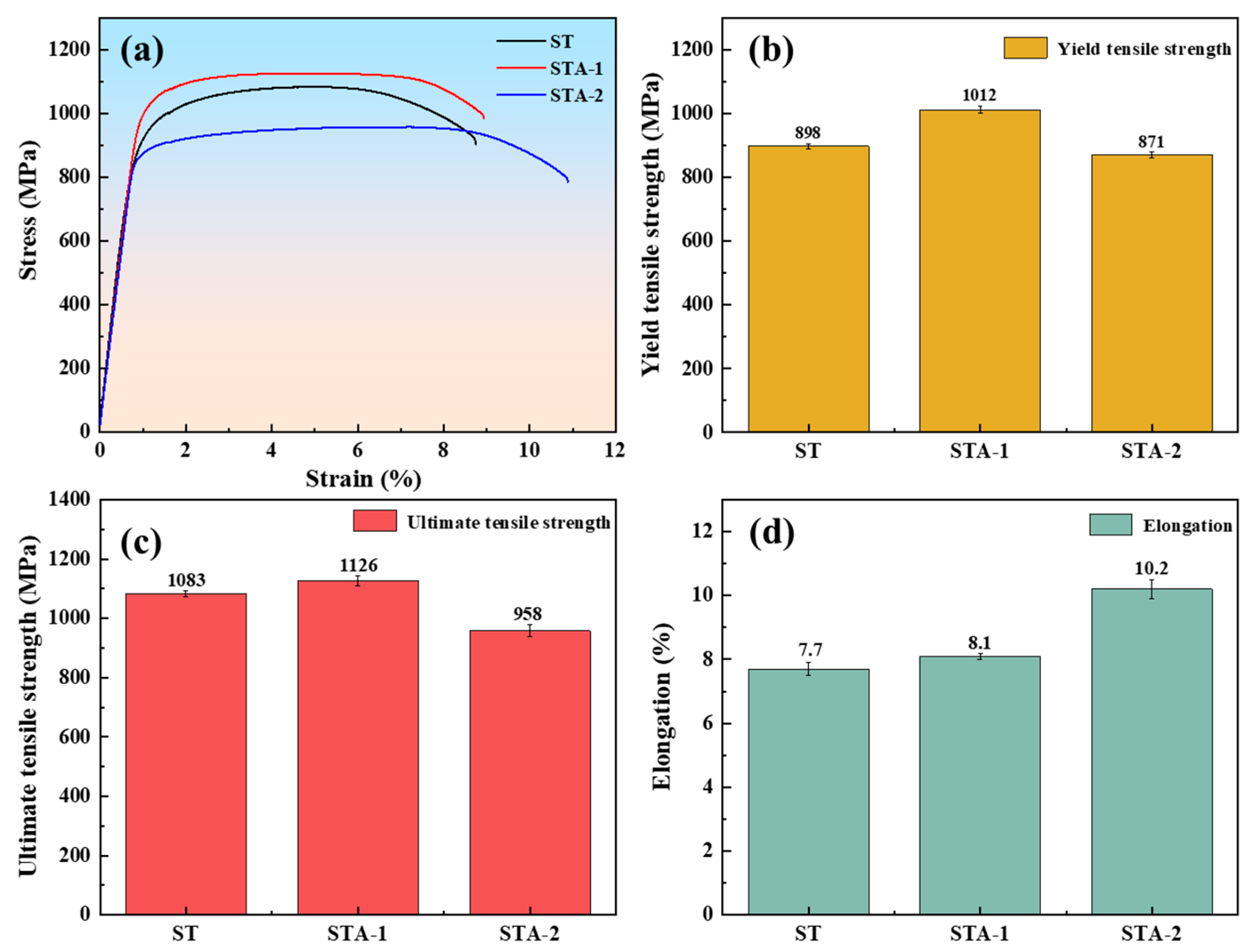
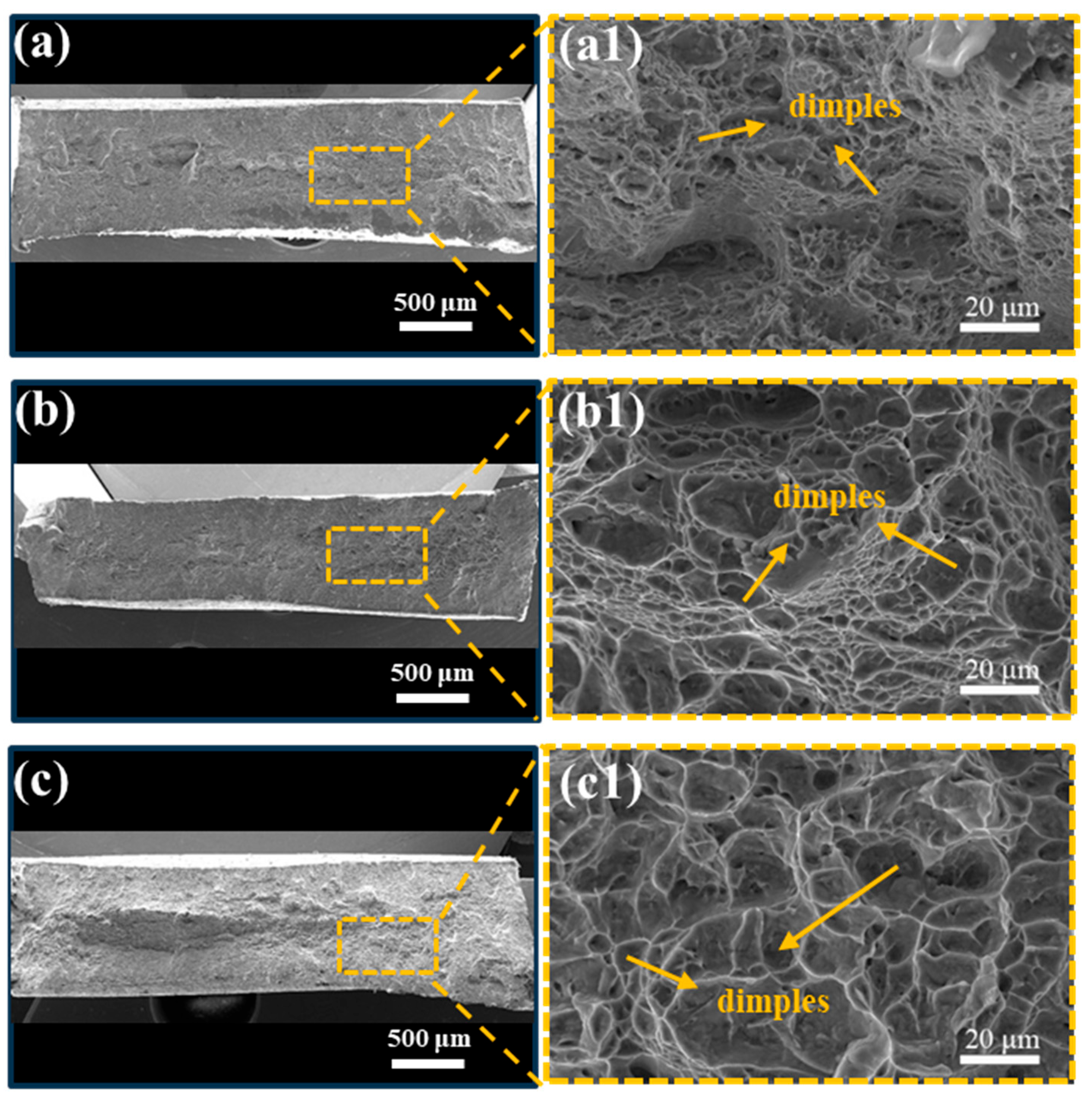

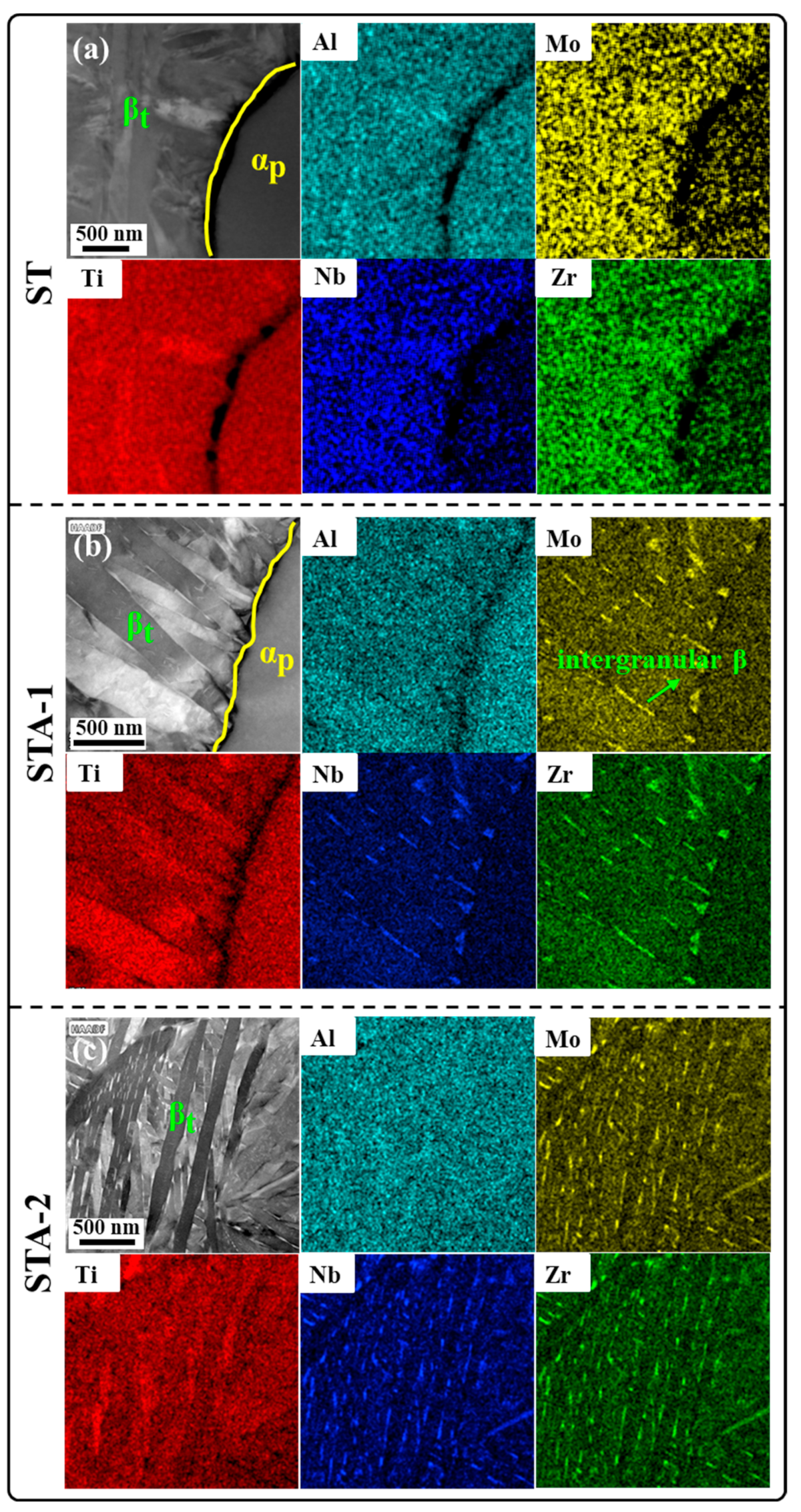
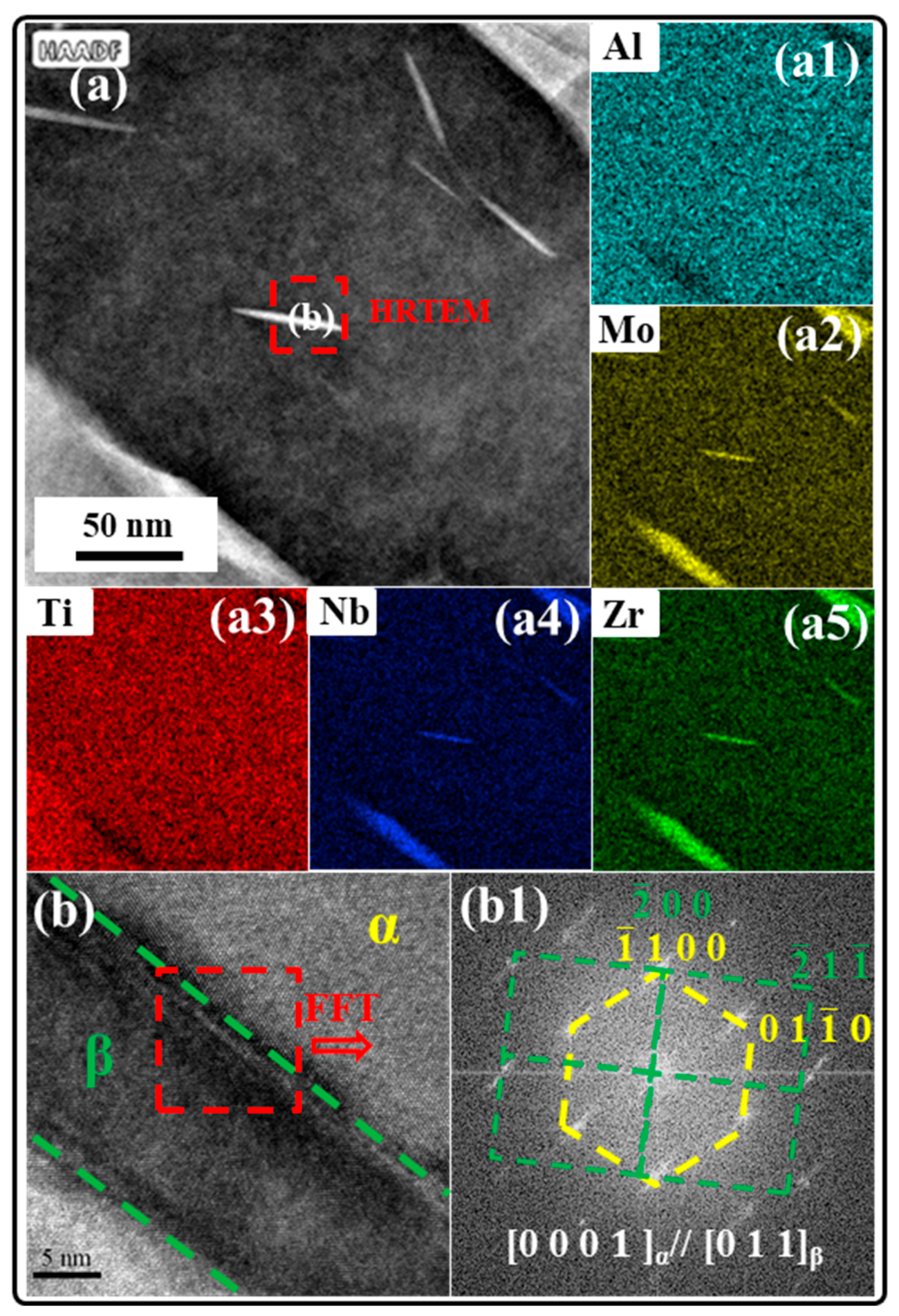
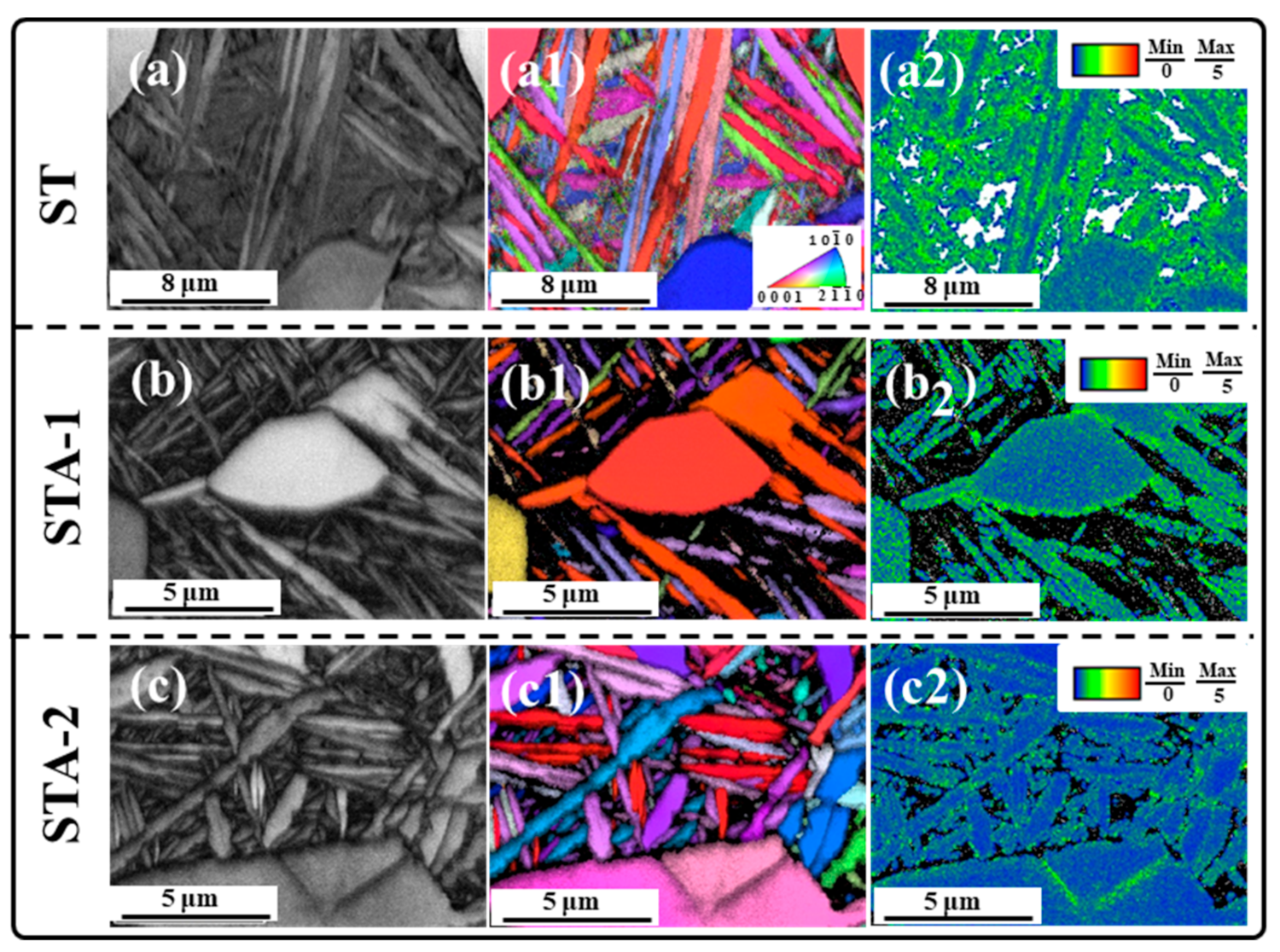

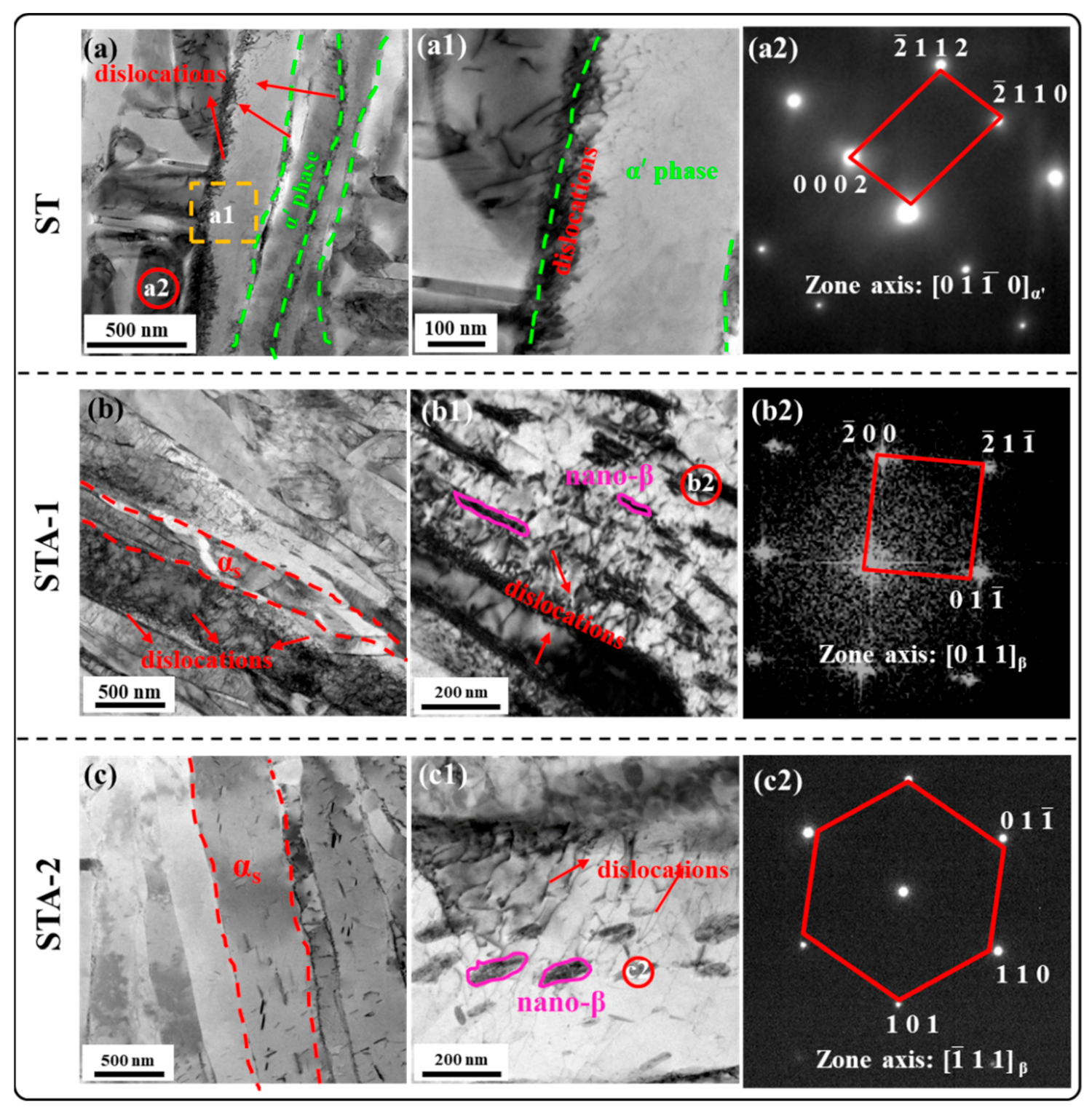

| Element | Al | Nb | Zr | Mo | Si | Fe | O | C | N | H | Ti |
|---|---|---|---|---|---|---|---|---|---|---|---|
| Wt.% | 6.30 | 3.04 | 2.04 | 1.07 | <0.03 | 0.1 | 0.039 | 0.0085 | 0.0040 | <0.001 | Bal. |
| Heat Treatment Samples | Fraction of αp Phase/% | Width of αp Phase/μm |
|---|---|---|
| ST | 31.1 ± 3.7 | 8.0 ± 0.3 |
| STA-1 | 33.5 ± 1.2 | 7.9 ± 0.4 |
| STA-2 | 32.0 ± 3.0 | 8.1 ± 0.3 |
| Sample | Vickers-Hardness/HV |
|---|---|
| ST | 331 ± 4 |
| STA-1 | 354 ± 7 |
| STA-2 | 301 ± 5 |
Disclaimer/Publisher’s Note: The statements, opinions and data contained in all publications are solely those of the individual author(s) and contributor(s) and not of MDPI and/or the editor(s). MDPI and/or the editor(s) disclaim responsibility for any injury to people or property resulting from any ideas, methods, instructions or products referred to in the content. |
© 2024 by the authors. Licensee MDPI, Basel, Switzerland. This article is an open access article distributed under the terms and conditions of the Creative Commons Attribution (CC BY) license (https://creativecommons.org/licenses/by/4.0/).
Share and Cite
Xiao, C.; Hu, B.; Ge, J.; Kong, B.; Luo, D.; Zhang, X.; Zhou, K. Revealing the Effect of α’ Decomposition on Microstructure Evolution and Mechanical Properties in Ti80 Alloy. Materials 2024, 17, 2238. https://doi.org/10.3390/ma17102238
Xiao C, Hu B, Ge J, Kong B, Luo D, Zhang X, Zhou K. Revealing the Effect of α’ Decomposition on Microstructure Evolution and Mechanical Properties in Ti80 Alloy. Materials. 2024; 17(10):2238. https://doi.org/10.3390/ma17102238
Chicago/Turabian StyleXiao, Chunhong, Bin Hu, Jinyang Ge, Bin Kong, Deng Luo, Xiaoyong Zhang, and Kechao Zhou. 2024. "Revealing the Effect of α’ Decomposition on Microstructure Evolution and Mechanical Properties in Ti80 Alloy" Materials 17, no. 10: 2238. https://doi.org/10.3390/ma17102238




